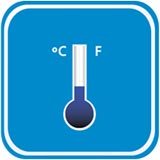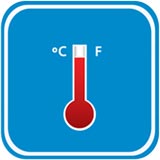From the Resene paint and decorating problem solver
Just what makes the ideal painting day? It’s important to get it right or chances are you’ll be less than satisfied with the results. ‘Ideal’ is a tough concept, though – like most things, you’re best to aim for moderation.
So, what is ideal? 15-20°C, humidity 70-80% and a very gentle breeze.
Rule to remember: Is the washing on the line drying? If it’s not, neither will your paint.
Is the washing on the line drying? If it’s not, neither will your paint.
If water spilt on a concrete path doesn’t dry out, leave your painting until it does.
If a thin coat of water applied to the substrate has not evaporated in 15 minutes, leave your painting until it does.
A light breeze is ideal for drying your paint. If it’s too windy, your paint will dry too fast, so move operations to a more sheltered side of the building.
Don’t paint in direct sunlight or in extremely hot weather. If you’re pushed, paint the shady side of the building or wait until the temperature drops. A good idea is to start ahead of the sun and work your way around the building keeping ahead of the sun as you go.
Cloudy or overcast conditions are ideal for painting… provided it’s not raining and rain is not expected.
As a general rule apply waterborne paints at temperatures above 10°C and solventborne and industrial paints when the temperature is at least 5°C above the dew point. The lower the temperature the longer the paint will take to dry.
Read the label on your paint container. If you follow its recommendations, you’ll reap the full benefit of the protective capabilities and finish of your paint.
Common outdoor weather conditions may not appear to be particularly harsh, but they put tremendous demands on exterior paint. The most damaging of these are: sunlight and ultraviolet (U.V.) radiation, water and moisture, and temperature changes.
Higher quality exterior paints help to combat the effects of each of these conditions.

Direct sunshine can degrade the binder and pigment of paint, resulting in chalking, erosion and colour loss. While all paints suffer these effects to some degree, lower quality paints (and interior paints) will generally fail in these ways much earlier than quality exterior paints.
Waterborne paint binders usually resist the effects of direct sunlight better than the binders in solventborne paints, as the waterborne paint binders tend to be ‘transparent’ to U.V. radiation, while solventborne binders actually absorb the radiation, which breaks them down. Some paint colours, such as bright organic reds and yellows, are more vulnerable to fading caused by U.V. radiation. For these colours, a final coat of Resene Clearcoat UVS (see Data Sheet D502) with U.V. inhibitors can help the colours last longer.

In combination with U.V. radiation, moisture tests the paint’s resistance to chalking and fading. Generally higher quality waterborne paints perform better because of the characteristics of the binders they contain.
Changes in the moisture content of the substrate can also cause problems, especially with wood, hardboard and Plywood. When a wet substrate expands or a drying substrate contracts, it can stress the paint, resulting in cracking and flaking. Permeable or ‘breathable’ waterborne paint allows the water to vaporise and escape. High quality waterborne paints with a high binder content are very flexible, offering added protection against problems with cracking and flaking.
Water and moisture can also cause blistering of exterior paints, and create an environment that is conducive to mould growth. Top quality paints typically contain special additives called fungicides that help prevent mould from forming. Resene Quick Dry waterborne primer undercoat (see Data Sheet D45), Resene TimberLock (see Data Sheet D48) and Resene Wood Primer (see Data Sheet D40) all contain substantial quantities of fungicide for extra protection. Consider asking for Resene MoulDefender, a mould inhibitor, to be added to paint being used in mould prone areas to inhibit mould growth. Fungicides inhibit mould growth but do not kill existing mould. Any mould present prior to painting should be treated with Resene Moss & Mould Killer (see Data Sheet D80).

For water to evaporate from a waterborne paint there needs to be some spare room, usually expressed as relative humidity, in the surrounding air for it to go into. Relative humidity tells us how much water vapour there is in the air compared with how much it can actually hold. The ability of the air to hold water vapour lessens dramatically as temperatures fall and the evaporation of water from a paint film may cease altogether with relatively small temperature changes of just 5°C.
At a relative humidity of about 100% water in a waterborne paint film can be likened to a car trying to get onto a busy motorway at peak hour traffic time. There is just so much traffic already there that there is no room for any more cars. At low temperatures water will have little extra energy to get up to the speed necessary to merge in with the traffic. This will lead to easy application – beautiful flow – but there is also a risk of water-sensitive materials accumulating on the surface.
If the temperature drops and the humidity increases, the paint stops losing water. If the temperature change was due the onset of sunset then there are likely to be serious problems with the paint. Any further decrease in temperature will result in dew formation and areas out of direct sunlight will feel the effects of this sooner rather than later. In the very worst case the paint will just not coalesce at all and be washed off by dew. At best the paint’s film formation and ability to withstand mild weathering will be compromised. Blistering or surfactant leaching can occur.
Heavier coats of paint will take longer to dry and this will allow more time for temperatures to possibly fall and increase the probability of paint getting caught by high relative humidity.
Decorators should beware of calm, still autumn afternoons when skies are blue, as humidity related problems are more likely. Low humidity means the air is thirsty for moisture and will grab it, fast, from anywhere – such as a paint film.
Low humidity, high temperatures and a porous surface will lead to rapid loss of water and rapid drying. So fast, in fact, that the particles in the film won’t have time to arrange themselves properly

All paints get thick (or more viscous) in the cold and are much harder to use, especially solventborne enamels. One answer is to add thinners, but this has the side-effect of reducing film build and therefore appearance. A better solution is to stand the paint in warm water, which makes it much easier to apply and helps get that smooth, brush mark-free finish that you want.
At lower temperatures solventborne paints will continue to lose solvent but at temperatures about 3°C the chemical cross linking drying process will stop. The solventborne paint will remain soft and be vulnerable to physical damage. When temperatures return to normal the solventborne paint will continue its drying process. Heavily tinted solventborne paints may flatten off in gloss if caught by sudden rises in humidity during the drying process.
Lower temperatures and high humidity will significantly slow down the dry time of waterborne paints. The plastic particles that make up the waterborne binder will harden in the cold to the extent that they can’t fuse together to form a film. This can result in cracks forming and sometimes the whole paint film drying to a powder.
The Resene wintergrade range of topcoats and primers may be used in temperatures down to 2°C. Do not use when rain, snow or ice is expected, or in warm weather as the wet edge time will be too short to get a good finish.

There will be times when paint is very difficult to apply due to heat, such as on a corrugated iron roof painted dark brown in the middle of a hot summer day. In these conditions, it is best to cease painting. Painting in very hot conditions will result in water evaporating out of the paint very quickly and as a result the paint will thicken up and be very difficult to apply evenly. It will be difficult to keep a wet edge and brush or roller marks will not flow out. Paint brushes will tend to clog up and cans of paint can skin over quite rapidly.
The binder in waterborne paint consists of extremely small spherical particles of solid polymer. When the paint is applied and dries, these particles must fuse together to form a continuous, tough film and bind the pigment particles together. To occur properly, this fusion (or ‘coalescence’) takes a certain amount of time to occur and requires a certain degree of softness of the binder particles. If the paint is applied under conditions that force it to dry too quickly, it will be impossible for the paint to form a good, durable film even though the paint may look fine.
To help overcome this, Resene Hot Weather Additive, which can slow down the drying and give a longer wet edge, can be added to the paint. And if the surface is porous, it can be pre-wetted with water before the application of waterborne paints.
Applying solventborne paints on very hot days generally results in thick wet films that dry rapidly from the top. In these conditions wrinkling on recoat may be a problem.
If you are planning to paint a dark colour and your home is already too hot in summer, consider choosing a Resene CoolColour™. A Resene CoolColour is designed to reflect much more of the sun’s energy than a standard colour reducing heat buildup.

Checking the weather is also important for interior painting. When painting indoors the same rules regarding temperature and humidity still apply – that is, avoid painting in high humidity, low or high temperatures.
Ventilation is important when painting inside to ensure sufficient air circulation to help the paint cure correctly and to allow any solvents that may be released during the drying process to dissipate.
Resene Paint and Decorating Problem Solver
Learn more about typical painting problems and situations you may find when decorating.